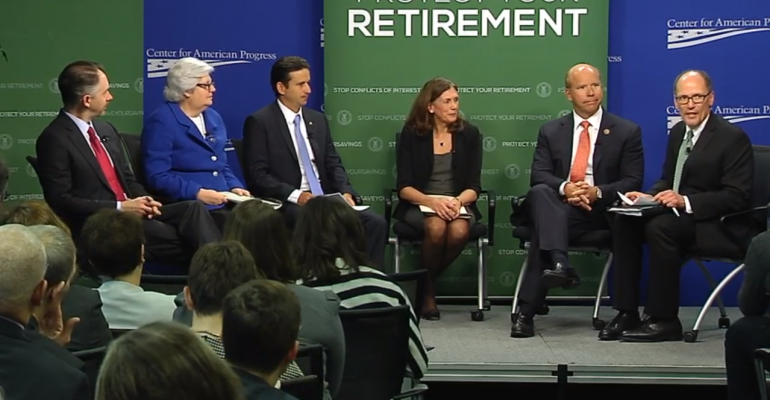The financial industry is in a tizzy as the Department of Labor released the long-anticipated final version of the new rules addressing conflicts of interest in retirement advice earlier today. Weighing in at over 1,000 pages, the collected documents that make up the new rules are imposing, to say the least. Here’s an overview of the broad strokes.
What Do the Rules Govern? Advisors that provide investment advice to plans, plan sponsors, fiduciaries, plan participants, beneficiaries, IRAs and IRA owners must avoid payments that create conflicts of interest (unless they comply with an exemption). Advisors will be required to adhere to a fiduciary standard, make prudent investment recommendations without regard to any interests other than those of the customer, charge only reasonable compensation and make no misrepresentations to their customers regarding recommended investments. Advisors will also be obligated to acknowledge their status as fiduciaries.
When Do the Rules Go Into Effect? April 2017 (four months further out than in the proposed version). It’s also important to note that two major exceptions are phasing in gradually to give firms time to adjust. The Best Interest Contract Exemption and the Principal Transactions Exemption will have a transition period during which fewer conditions apply, from April 2017 to Jan. 1, 2018, at which time the rule will be fully implemented.
What Isn’t Considered Investment Advice?
General Communications. Large circulation newsletters, publicly broadcasted commentary, conference presentations, marketing materials, market research and other like items gathered for general distribution that no reasonable person would view as investment recommendations are exempt.
Platform Providers. Simply making available a platform of investment alternatives without regard to the individualized needs of the plan, its participants or beneficiaries, if the plan fiduciary is independent of the service provider, isn’t a recommendation—as long as the provider also represents in writing to the plan fiduciary that they are not providing impartial investment advice or giving advice in a fiduciary capacity.
Transactions With Independent Plan Fiduciaries With Financial Expertise. Communications with independent plan fiduciaries are exempt if the advisor reasonably believes that the independent fiduciary is a licensed and regulated provider of financial services or has responsibility for the management of at least $50 million in assets (among other conditions).
Swap and Security-Based Swap Transactions. Communications and activities made by advisors to ERISA-covered employee benefit plans in swap or security-based swap transactions do not result in the advisors becoming investment advice fiduciaries to the plan if certain conditions are met.
The Best Interest Contract Exemption. Under the rule, advisors who provide fiduciary investment advice to plan sponsors, plan participants and IRA owners are not permitted to receive payments creating conflicts of interest without a specific prohibited transaction exemption granted by the Secretary of Labor.
However, the Best Interest Contract Exemption (BICE) allows firms to continue to rely on compensation and fee practices currently in place, provided they follow certain steps to mitigate conflicts of interest and that they provide investment advice that’s in the “best interest” of their customers. Basically, they have to abide by a basic fiduciary standard and disclose any potential conflicts of interest. (Note that while the 2015 proposed rules limited the asset classes covered by this exemption, that limitation no longer exists in the final version and the exemption applies to any investment product.)
Proper disclosure includes an array of requirements, most notably the creation and maintenance of a disclosure website that lays out the firm’s business model and associated material conflicts of interest, a written description of the firm’s policies and procedures to mitigate conflicts, and disclosures of compensation and incentive arrangements with advisors.
This exemption is also important because it provides the legal recourse against bad actors that clients previously lacked. Financial institutions must now commit to these protective conditions as part of an enforceable contract, giving rise to potential breach-of-contract claims for failure to comply. Advisors must also acknowledge their fiduciary status, which allows ERISA plan investors to assert their rights under statutory protections.
Advisors worried about frivolous suits over poor investment performance need not fear. Cases will be adjudicated consistent with long-existing ERISA jurisprudence. Advisors can prove they acted in their clients’ best interest by documenting their use of a reasonable process and adherence to professional standards, and by documenting their compliance with the firm’s stated policies and procedures (which are required to be laid out under the BICE).
The Principal Transactions Exemption. This exemption allows advisors to buy or sell certain recommended debt securities or other investments out of their own inventories to or from plans and IRAs. Doing so requires adherence to a fiduciary standard similar to that under the BICE and to obtain the best execution reasonably available under the circumstances of the transaction.
PTE 84-24. Finally, the rules allow advisors to receive compensation for recommending fixed-rate annuity contracts to plans and IRAs. The exemption allowing these simpler, lifetime income products features a much more streamlined set of requirements than the BICE. On the other hand, more complex products, like variable lifetime annuities and indexed annuities, may still be recommended by advisors but must abide by the full terms of the BICE.
Though this is by no means an exhaustive list of everything the new rules have to offer, hopefully these highlighted points provide advisors with some guidelines as to what to take note of when struggling through the official documents.





